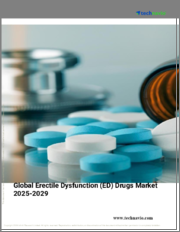
|
시장보고서
상품코드
1524242
발기부전 치료기기 시장 : 기기 유형별, 연령대별, 원인별, 최종 용도별 - 예측(2024-2032년)Erectile Dysfunction Device Market - By Device Type (Non-Surgical Devices, Surgical Devices), By Age Group (<40, 40 -60 years, >60), By Cause (Diabetes, Neurological disorders, Hypertension), By End-use (Hospitals, Clinics, ASCs) & Forecast, 2024 - 2032 |
||||||
발기부전 치료기기 세계 시장은 2024년부터 2032년까지 연평균 9.3% 이상의 성장률을 나타낼 것으로 예상됩니다.
사회적 금기에 도전하고 열린 대화를 촉진함으로써 이러한 이니셔티브는 남성들이 두려움이나 부끄러움 없이 필요한 의료 지원을 받을 수 있도록 힘을 실어줍니다. 이러한 문화적 전환은 개인의 건강 성과를 향상시키고 발기부전 치료기기 시장의 성장을 가속합니다.
예를 들어, 2023년 11월 망고알엑스(MangoRx)는 남성 건강 의식에 초점을 맞춘 자선 캠페인을 시작했습니다. 이 회사는 한 달 동안 브랜드 제품 판매 수익의 50%를 다양한 남성 건강 및 웰빙 자선 단체에 기부할 것을 약속했습니다.
더 많은 남성들이 자신의 고민을 털어놓고 의료 서비스를 이용할수록 의료기기 및 치료법을 포함한 효과적인 솔루션에 대한 수요가 증가할 것입니다. 결국, 발기부전 치료 시장을 확대하고 환자 치료 전반을 개선하는 데 있어 낙인 제거 노력은 중요한 역할을 할 것입니다.
외과용 기기 분야는 2024년부터 2032년까지 놀라운 CAGR을 나타낼 것으로 보입니다. 음경 임플란트와 같은 수술기구는 발기부전에 대한 장기적인 해결책을 제공하며, 다른 치료법이 효과가 없는 환자에게 선호될 수 있습니다. 또한, 수술 기술 및 기구 설계의 발전으로 합병증과 회복 시간이 단축되고 치료 결과가 개선되고 있습니다. 인식이 개선되고 발기부전에 대한 편견이 줄어들면서 성기능을 회복하기 위한 실행 가능한 해결책으로 수술적 옵션을 고려하는 남성들이 증가하고 있습니다. 이러한 추세는 환자를 위한 효과적이고 내구성 있는 치료 옵션을 찾는 의료진에 의해 뒷받침되고 있습니다.
신경질환 분야는 다발성 경화증(MS), 척수 손상 SCI 등 발기부전을 유발할 수 있는 질환의 확산으로 인해 2032년까지 발기부전 치료기기 시장에서 주목할 만한 점유율을 차지할 것으로 예상됩니다. 이러한 환자들은 성기능에 영향을 미치는 신경학적 측면과 발기를 달성하고 유지하는 신체적 능력에 대한 전문적인 치료가 필요한 경우가 많은데, 발기부전 치료 기기는 종합적인 치료 계획에 포함될 수 있는 비침습적 또는 저침습적 치료 옵션을 제공하고, 이러한 환자들에게 근본적인 신경학적 상태에도 불구하고 성기능을 회복하고 삶의 질을 향상시킬 수 있는 기회를 제공합니다.
유럽의 발기부전 치료기기 시장은 2032년까지 유망한 CAGR로 큰 성장을 기록할 것으로 보입니다. 유럽의 고령화와 발기부전이 치료 가능한 질환이라는 인식과 수용도가 높아지면서 발기부전 치료기기와 같은 효과적인 솔루션에 대한 수요가 증가하고 있습니다. 많은 유럽 국가들의 의료 인프라 및 상환 정책의 혁신으로 인해 더 많은 사람들이 이러한 기기를 쉽게 이용할 수 있게 되었습니다. 건강 관리와 삶의 질에 대한 문화적 관점도 기여하고 있으며, 더 많은 남성들이 눈에 띄지 않고 효과적으로 성기능을 회복할 수 있는 비침습적 치료법을 찾고 있어 시장 성장에 기여하고 있습니다.
목차
제1장 조사 방법과 조사 범위
제2장 주요 요약
제3장 업계 인사이트
- 생태계 분석
- 업계에 대한 영향요인
- 성장 촉진요인
- 업계의 잠재적 리스크&과제
- 성장 가능성 분석
- 규제 상황
- 기술적 전망
- 상환 시나리오
- Porter's Five Forces 분석
- PESTEL 분석
제4장 경쟁 구도
- 서론
- 기업 매트릭스 분석
- 주요 시장 기업 - 경쟁 분석
- 경쟁 포지셔닝 매트릭스
- 전략 대시보드
제5장 시장 추산·예측 : 기기 유형별, 2021-2032년
- 주요 동향
- 비수술 기기
- 발기부전용 충격파 발생기
- 진공 수축 장치
- 외부 음경 경직 기기
- 수술 기기
- 음경 임플란트
- 풍선 임플란트
- 연성 임플란트
- 기타 수술 기기
- 음경 임플란트
제6장 시장 추산·예측 : 연령층별, 2021-2032년
- 주요 동향
- 40세 미만
- 40-60세
- 60세 이상
제7장 시장 추산·예측 : 원인별, 2021-2032년
- 주요 동향
- 당뇨병
- 신경질환
- 고혈압
- 기타 원인
제8장 시장 추산·예측 : 최종 용도별, 2021-2032년
- 주요 동향
- 병원
- 진료소
- 외래수술센터(ASC)
- 기타 최종사용자
제9장 시장 추산·예측 : 지역별, 2021-2032년
- 주요 동향
- 북미
- 미국
- 캐나다
- 유럽
- 독일
- 영국
- 프랑스
- 스페인
- 이탈리아
- 네덜란드
- 기타 유럽
- 아시아태평양
- 중국
- 일본
- 인도
- 호주
- 한국
- 기타 아시아태평양
- 라틴아메리카
- 브라질
- 멕시코
- 기타 라틴아메리카
- 중동 및 아프리카
- 남아프리카공화국
- 사우디아라비아
- 아랍에미리트(UAE)
- 기타 중동 및 아프리카
제10장 기업 개요
- Augusta Medical Systems
- Boston Scientific Corporation
- Coloplast Corporation
- Medispec Ltd.
- MTS Medical UG
- NOVAmedtek
- Owen Mumford Ltd.
- Promedon
- SILIMED
- STORZ MEDICAL AG
- Zephyr Surgical Implants
- Zimmer Aesthetics
Global Erectile Dysfunction Device Market will indicate over 9.3% CAGR between 2024 and 2032, driven by escalating efforts to destigmatize erectile dysfunction by advocacy groups and healthcare providers globally. By challenging societal taboos and promoting open dialogue, these initiatives empower men to seek necessary medical assistance without fear or shame. This cultural shift enhances individual health outcomes and fuels market growth for erectile dysfunction treatments.
For instance, in November 2023, MangoRx launched a charitable campaign focusing on mens health awareness. The company pledges to donate 50% of sales proceeds from its branded merchandise throughout the month to support various mens health and wellness charities.
As more men feel comfortable discussing their concerns and accessing healthcare services, demand rises for effective solutions, including medical devices and therapies. Ultimately, destigmatization efforts play a crucial role in expanding the market for erectile dysfunction treatments, enhancing overall patient care.
The overall erectile dysfunction device market is classified based on device type, age group, cause, end-use, and region.
The surgical devices segment will register an impressive CAGR from 2024 to 2032. Surgical devices, such as penile implants, offer a long-term solution for ED that may be preferred by patients who have not responded well to other treatments. Moreover, advancements in surgical techniques and device design have improved outcomes, reducing complications and recovery times. As awareness grows and the stigma surrounding ED diminishes, more men are exploring surgical options as a viable solution to restore sexual function. This trend is supported by healthcare providers seeking effective, durable treatment options for their patients.
The neurological disorders sector will seize a notable erectile dysfunction device market share by 2032 because of the prevalence of conditions such as multiple sclerosis MS and spinal cord injuries SCI that can lead to ED. These patients often require specialized treatments that can address both the neurological aspects affecting sexual function and the physical ability to achieve and maintain an erection. ED devices provide non-invasive or minimally invasive options that can be integrated into comprehensive treatment plans, offering these patients a chance to regain sexual function and improve their quality of life despite their underlying neurological conditions.
Europe erectile dysfunction device market will register significant growth, with a promising CAGR through 2032. Europe aging population, coupled with increasing awareness and acceptance of ED as a treatable condition, has fueled demand for effective solutions like ED devices. Innovations in healthcare infrastructure and reimbursement policies in many European countries have made these devices more accessible to a broader demographic. Cultural attitudes toward healthcare and quality of life also contribute, as more men seek out non-invasive treatments that can restore sexual function discreetly and effectively, bolstering market growth.
Table of Contents
Chapter 1 Methodology & Scope
- 1.1 Market scope & definitions
- 1.2 Research design
- 1.2.1 Research approach
- 1.2.2 Data collection methods
- 1.3 Base estimates & calculations
- 1.3.1 Base year calculation
- 1.3.2 Key trends for market estimation
- 1.4 Forecast model
- 1.5 Primary research and validation
- 1.5.1 Primary sources
- 1.5.2 Data mining sources
Chapter 2 Executive Summary
- 2.1 Industry 360° synopsis
Chapter 3 Industry Insights
- 3.1 Industry ecosystem analysis
- 3.2 Industry impact forces
- 3.2.1 Growth drivers
- 3.2.1.1 Increasing prevalence of erectile dysfunction
- 3.2.1.2 Technological advancement in devices
- 3.2.1.3 Growing awareness and acceptance
- 3.2.1.4 Rise in R&D investment
- 3.2.2 Industry pitfalls & challenges
- 3.2.2.1 Risk of complications
- 3.2.1 Growth drivers
- 3.3 Growth potential analysis
- 3.4 Regulatory landscape
- 3.5 Technological landscape
- 3.6 Reimbursement scenario
- 3.7 Porter's analysis
- 3.8 PESTEL analysis
Chapter 4 Competitive Landscape, 2023
- 4.1 Introduction
- 4.2 Company matrix analysis
- 4.3 Competitive analysis of major market players
- 4.4 Competitive positioning matrix
- 4.5 Strategy dashboard
Chapter 5 Market Estimates and Forecast, By Device Type, 2021 - 2032 ($ Mn)
- 5.1 Key trends
- 5.2 Non-surgical devices
- 5.2.1 Erectile dysfunction shock wave generators
- 5.2.2 Vacuum constriction devices
- 5.2.3 External penile rigidity devices
- 5.3 Surgical devices
- 5.3.1 Penile implants
- 5.3.1.1 Inflatable implants
- 5.3.1.2 Malleable implants
- 5.3.2 Other surgical devices
- 5.3.1 Penile implants
Chapter 6 Market Estimates and Forecast, By Age Group, 2021 - 2032 ($ Mn)
- 6.1 Key trends
- 6.2 Less than 40
- 6.3. 40-60 years
- 6.4 More than 60 years
Chapter 7 Market Estimates and Forecast, By Cause, 2021 - 2032 ($ Mn)
- 7.1 Key trends
- 7.2 Diabetes
- 7.3 Neurological disorders
- 7.4 Hypertension
- 7.5 Other causes
Chapter 8 Market Estimates and Forecast, By End-Use, 2021 - 2032 ($ Mn)
- 8.1 Key trends
- 8.2 Hospitals
- 8.3 Clinics
- 8.4 Ambulatory surgical centers
- 8.5 Other end-users
Chapter 9 Market Estimates and Forecast, By Region, 2021 - 2032 ($ Mn)
- 9.1 Key trends
- 9.2 North America
- 9.2.1 U.S.
- 9.2.2 Canada
- 9.3 Europe
- 9.3.1 Germany
- 9.3.2 UK
- 9.3.3 France
- 9.3.4 Spain
- 9.3.5 Italy
- 9.3.6 Netherlands
- 9.3.7 Rest of Europe
- 9.4 Asia Pacific
- 9.4.1 China
- 9.4.2 Japan
- 9.4.3 India
- 9.4.4 Australia
- 9.4.5 South Korea
- 9.4.6 Rest of Asia Pacific
- 9.5 Latin America
- 9.5.1 Brazil
- 9.5.2 Mexico
- 9.5.3 Rest of Latin America
- 9.6 Middle East and Africa
- 9.6.1 South Africa
- 9.6.2 Saudi Arabia
- 9.6.3 UAE
- 9.6.4 Rest of Middle East and Africa
Chapter 10 Company Profiles
- 10.1 Augusta Medical Systems
- 10.2 Boston Scientific Corporation
- 10.3 Coloplast Corporation
- 10.4 Medispec Ltd.
- 10.5 MTS Medical UG
- 10.6 NOVAmedtek
- 10.7 Owen Mumford Ltd.
- 10.8 Promedon
- 10.9 SILIMED
- 10.10 STORZ MEDICAL AG
- 10.11 Zephyr Surgical Implants
- 10.12 Zimmer Aesthetics



















